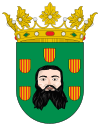Barbastro facts for kids
Quick facts for kids
Barbastro
|
||
|---|---|---|
 |
||
|
||
| Country | Spain | |
| Autonomous community | Aragon | |
| Province | Huesca | |
| Comarca | Somontano de Barbastro | |
| Judicial district | Barbastro | |
| Area | ||
| • Total | 107.60 km2 (41.54 sq mi) | |
| Elevation | 341 m (1,119 ft) | |
| Population
(2018)
|
||
| • Total | 16,944 | |
| • Density | 157.472/km2 (407.851/sq mi) | |
| Demonym(s) | Barbastrinenses | |
| Time zone | UTC+1 (CET) | |
| • Summer (DST) | UTC+2 (CEST) | |
| Postal code |
22300
|
|
Barbastro is a historic city in the Somontano county, located in the province of Huesca, Spain. Its name comes from the Latin words Barbastrum or Civitas Barbastrensis. In the Aragonese language, it is called Balbastro. The city sits where the Cinca and Vero rivers meet. It was once known as Barbastra or Bergiduna.
Contents
Exploring Barbastro's Past
Ancient Roots of Barbastro
Barbastro has a very long history. It was first an ancient Celtiberian city called Bergidum or Bergiduna. Later, during Roman times, it was known as Brutina. It became part of the Hispania Citerior region, and then Hispania Tarraconensis.
Barbastro in the Middle Ages
After the Western Roman Empire fell, Barbastro was part of the Visigoth kingdom. In 717, Musa bin Nusair took over Barbastro and the Barbitaniya area. This was part of the Umayyad effort to conquer northern parts of Spain. The town was then called Madyar.
Later, the Banu Jalaf family settled here. They made Barbastro the capital of their emirate, which included Huesca. This emirate was known as Barbineta until 862, and then Brabstra until 882.
The Siege and Reconquest
In 1064, Sancho I of Aragon, who was the King of Aragón, led Christian forces to invade Barbastro. These forces included Franks led by William VIII of Aquitaine. At this time, Barbastro was part of the taifa of Zaragoza, which was a Muslim kingdom. This attack is known as the Siege of Barbastro.
Some old writings say that 50,000 people were killed or captured. However, modern historians believe this number is too high. The total population of the town was probably not more than 8,000 people. The very next year, Muslim forces took Barbastro back.
In 1101, Peter I of Aragon finally captured Barbastro for good. He made it a bishopric seat, which means it became an important religious center. From then on, Barbastro's history followed the history of Aragon and Spain.
Jewish Community in Barbastro
During the Middle Ages, a Sephardic Jewish community lived and thrived in Barbastro. They faced fewer problems compared to Jewish people in other parts of Spain. The first time we see records of Jewish people in Barbastro is from 1144. After an important debate called the Disputation of Tortosa, the Jewish community in Barbastro ended. This was because many people became conversos, meaning they converted to Christianity. The old synagogue, which was their place of worship, then became a meeting place for conversos.
Modern Times and Economy
Barbastro's economy grew strong until the early 1900s. After that, it went through a period where things were not as good. This decline ended in the 1960s, thanks to more agricultural products being grown.
During a difficult time in Spanish history, Barbastro also experienced conflict. The city has since recovered and continues to be an important part of the region.
Famous People from Barbastro
Many notable people have come from Barbastro:
- Bartolomé and Lupercio de Argensola: These brothers were historians and poets. They were important figures during the Spanish siglo de oro, a time when arts and literature in Spain were at their best.
- Antonio Ricardos Carrillo de Albornoz: He was a famous Spanish army general in the 18th century.
- Josemaría Escrivá: He was the founder of Opus Dei, an important institution within the Roman Catholic Church.
- María Pilar Crespí Pérez: She was a chemist who studied at the Universidad Complutense de Madrid. She also worked as a teacher at the Colegio Estudio.
Sister Cities
Barbastro has a special connection with another city:
 Saint-Gaudens, Haute-Garonne, France
Saint-Gaudens, Haute-Garonne, France
See also
 In Spanish: Barbastro para niños
In Spanish: Barbastro para niños



